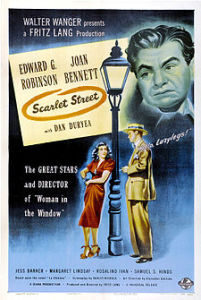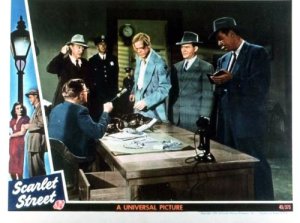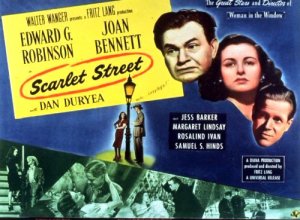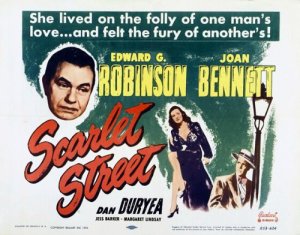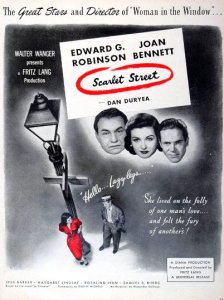Scarlet Street ***** (1945, Edward G Robinson, Joan Bennett, Dan Duryea) – Classic Movie Review 2173
Director Fritz Lang is in his element with the splendidly dark and menacing 1945 black and white film noir movie Scarlet Street starring Edward G Robinson, Joan Bennett and Dan Duryea. It is one of Lang’s favourites of his films.
The hit star cast and crew from 1944’s The Woman in the Window return for another top-drawer murder thriller, this time taken from Georges de La Fouchardière’s French novel called La Chienne (The Bitch), dramatised as a stage play by André Mouëzy-Éon, and also the basis of Jean Renoir’s 1931 movie version, filmed under its original title as La Chienne.
Bennett plays a trashy femme fatale called Kitty March and Dan Duryea is her brutish boyfriend, a flashy wideboy named Johnny Prince, who set out on a plot to snare timid, middle-aged man Chris Cross (Robinson) into their wicked grasp. Bennett seduces Robinson, who then paints her a portrait, only to find out that she is using him for his money and fame.
There is outstanding playing all round, with Bennett and Duryea perfect in their seedy roles, but Robinson is especially marvellous as the New York cashier and spare-time painter who is so entranced by Bennett that he pretends to be a famous artist to enchant her and do his own ensnaring.
Also in the cast are Jess Barker, Margaret Lindsay, Rosalind Ivan, Samuel S Hinds, Arthur Loft, Vladimir Sokoloff, Charles Kemper, Russell Hicks, Cy Kendall, Tom Dillon and Anita Sharp-Bolster.
The New York State Censor Board banned Scarlet Street on 4 January 1946 under its power to censor films that were ‘obscene, indecent, immoral, inhuman, sacrilegious’ or whose screening ‘would tend to corrupt morals or incite to crime’. Censor boards in Milwaukee and Atlanta also banned the film.
In 2008, Scarlet Street was nominated for the American Film Institute’s Top 10 Gangster Films list.
Scarlet Street is directed by Fritz Lang, runs 102 minutes, is made by Fritz Lang Productions and Walter Wanger Productions [Diana Production], and released by Universal Pictures (1945) (US) and General Film Distributors (1946) (UK), is written by Dudley Nichols, based on Georges de La Fouchardière’s novel La Chienne, is shot in black and white by Milton Krasner, produced by Walter Wanger and Fritz Lang, is scored by Hans J Salter and is designed by Alexander Golitzen.
It is shot at Universal Studios, 100 Universal City Plaza, Universal City, California.
It is also available in a computer colorized version.
Renoir disliked both remakes Lang made of his films: La Chienne (1931) and La Bête Humaine (1938) which inspired Human Desire (1954).
The failure of the original copyright holder to renew the film’s copyright resulted in it falling into public domain.
John Decker’s 12 paintings for the film were sent to the Museum of Modern Art in New York City for exhibition in March 1946.
© Derek Winnert 2015 Classic Movie Review 2173
Check out more reviews on http://derekwinnert.com

